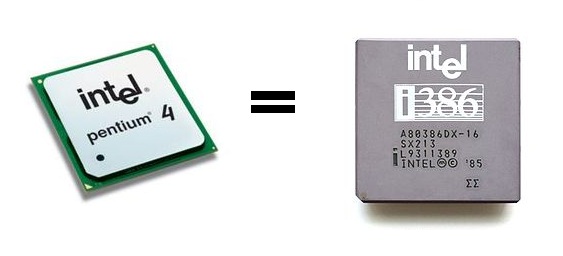Some realities in life as well as technology is hard to digest. So when I am trying to say that your high performance Pentium family of machine is an 80386 , it will not be that much appealing remembering the fact that the 80386 dates back to 1985 which is before the birth date of some of guys out here .
So what is the fact behind the Intel 386 or the i386 family of software products that we still use in our machines, are all of them dates back to 80’s ? I don’t think so .
So let us discuss some technical aspects behind the family of microprocessors so that the myths will be demystified .
Intel begins their microprocessor revolution with i4004 which was a 4 bit microprocessor. If you are still confused about the bits and bytes of processors, please check here .
Then the Intel moved to 8 bit with 8008 , 8080 and the 8085. The 8086 which was the first one to gulp data at 16 bit become the basic standard for computing industry which we refer to as X86 architecture .
8088 and 80286 were also 16 bit and after the success of the microprocessor 80286 , Intel released the 80386 which was one of the greatest designs of the Intel microprocessor R&D . The 32 bit platform offered the programmers to play around with the 32 bit operating systems and 32 bit application software.
So the point we are trying to establish is that the processor you are using may be still an 80386 , right ? so let us try to prove it .
After the huge success of 80386, intel produced the next generation of processors known as 80486. Even though it says that it is the next generation of microprocessors, it is nothing but an 80386 + 80387+ little bit or cache memory in to the processor core . So it is nothing but an 80386 with co-processor build in.
So we can say 80486 is still an i386
After 80486 Intel introduced the Intel Pentium. the name Pentium was used to protect Intel from branding issues of 80586 with their competing companies . But if we drive deep in to the Pentium architecture, we can see that it is two 80486 clubbed in to one core and they called it super scalar architecture. the major change was that the co-processor was redesigned so that it become 64 bit .
So the initial Pentium was nothing but two 80386 working simultaneously,
So we can say Pentium is still an i386
The Pentium MMX was nothing but the same chip with 57 new instructions called MMX instructions; Pentium pro was the same chip with plenty of cache memory and Pentium II was a Pentium Pro with MMX instructions. The initial Intel Celeron was nothing but the Pentium II with reduced amount of cache memory
So we can say Pentium II is still an i386
The much hyped Pentium III was a P- II with 71 new instructions which were strangely named Katmai new instructions.
So we can say Pentium III is still an i386
Irrespective of what Intel says about the Pentium 4 microprocessor which were introduced in year 2000
to achieve the same performance of the Pentium III Intel has to drive the Pentium 4 at almost double the frequency . Even though they did improved some instruction set to incorporate X64 instructions, it primarily continues to be an X86 architecture ,
So we can say Pentium 4 is still an i386
So until the introduction of recent generation of microprocessors with full IA 64 architecture , all your Intel family processors were 80386 with some frills added
( This is a broad under-estimation of the facts and we are aware that lot of other technical aspects are there which make all these processors superior to the 1985 model 80386 . But the sole aim of this post was to prove that even the new generation processors belong to i386 family from a software designer’s perspective)

ok, but you misses several points. you're right about all these processors sharing a common instruction set, but that's all they have in common. you can implement (from the hardware perspective) the same instruction set in several different ways, aiming to improve speed, power consumption, CPI and other things. it's a common instruction set, but completely different architectures.
if you're in doubt, take a look at the implementation of the datapaths of both the 80386 and 80486. they are completely different, and we are talking about some old technology. if you look at some more recent stuff, such as deeper pipelines, superscalar architectures and SMP you will see that they share almost nothing with the original 80386.
yes, the instruction set has been similar, and for a very good reason (compatibility). internally, things have changed a lot.
Yes , sure enough . My aim is not to say that all those new tech revolutions were fad , but to present the fact that all these chips has some thing in common